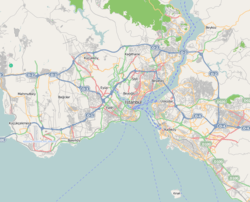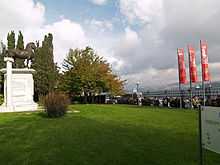Sakıp Sabancı Museum
| Sakıp Sabancı Museum | |
|---|---|
| Sakıp Sabancı Müzesi | |
 | |
 Location of Sakıp Sabancı Museum
| |
| Established | 2002 |
| Location | Emirgan, Istanbul |
| Coordinates | 41°05′57″N 29°03′13″E / 41.099116°N 29.053704°E |
| Type | University museum of art, calligraphy and archaeology |
| Director | Nazan Ölçer |
| Website | muze.sabanciuniv.edu |
The Sabancı University Sakıp Sabancı Museum (Turkish: Sakıp Sabancı Müzesi) is a private fine arts museum in Istanbul, Turkey, dedicated to calligraphic art, religious and state documents, as well as paintings of the Ottoman era. The museum was founded by Sakıp Sabancı, and was opened in June 2002. Aside from permanent exhibitions, the museum also hosts national and foreign temporary exhibitions and, hosts cultural events on the weekends.
Recently the museum gained worldwide attention when it exhibited the works of Pablo Picasso and Auguste Rodin.
History of the mansion


The historical building belonged to several high ranked pasha families and khedives, Egyptian governors, from 1848 until 1884, when it was purchased by the Ottoman Treasury on the orders of Sultan Abdülhamid II and presented as a gift to King Nicola I of Montenegro. The mansion served the next 30 years as a royal residence and embassy of Montenegro. In 1913, the Ottoman government repossessed it, which became home to the granddaughter of Sultan Mehmed V Reşad. After the foundation of the Turkish Republic, Prince Mehmed Ali Hasan, grandson of Khedive İsmail Paşa, purchased the then derelict house and commissioned the architect Edouard de Nari to build the present house. However, it remained unused for many years until the elder sister of the Egyptian prince made it her home in 1944.
In 1951 Hacı Ömer Sabancı, father of Sakıp Sabancı and founder of Sabancı Holding, purchased the mansion for spending summer months with his family. Inside the entrance gate of his mansion, he placed the bronze statue of a horse, he purchased at an auction. The sculpture was designed by Louis-Joseph Daumas in Paris in 1864 and cast by Vor Thiebaut. The house became popularly known as Atlı Köşk (Equestrian Villa). He and his family lived in the mansion until his decease in 1966. The mansion was home to Sakıp Sabancı and family between 1969 and 1999.
The mansion was leased in 1998 for a period of 49 years to Sabancı University along with all the antique furnishings and art collections. Today, the original mansion and a modern gallery annex host extensive art collections of 19th and 20th century.[1]
Exhibits
Collection

The collection of calligraphy consisting of nearly 400 pieces offers a comprehensive view of Ottoman calligraphic art over a period of 500 years, with manuscript Korans and prayer books, calligraphic panels, decrees, imperial documents, declarations, imperial seals, poetry books and calligraphic tools.
More than 320 selected paintings of Ottoman and Republican era belonging to Sabancı painting collection are on display, the works of notable Ottoman and Turkish artists like Osman Hamdi Bey, İbrahim Çallı, Halil Paşa, Nazmi Ziya Güran, Şeker Ahmet Paşa, Fikret Mualla and European artists like Fausto Zonaro and Ivan Ayvazovsky who lived and worked in the Ottoman Empire, either independently or as court pai
Items memorizing Sakıp Sabancı as pictures taken with personalities and statespersons, decorations and medals and some personal belongings are also on show.[2]
Temporary exhibitions
Temporary exhibitions that have taken place in and have left from the museum are listed below in chronological order:[3]
- (27.06.2003 - 05.05.2004) Partnership of Power: Artifacts from the Istanbul Archaeology Museum, Man and Horse
- (21.12.2003 - 18.04.2004) From the Medicis to the Savoias: Ottoman Splendour in Florentine Collections
- (12.05.2004 - 24.10.2004) Paris - St. Petersburg: Three Centuries of European Fashion from the Alexandre Vassiliev Collection
- (24.05.2005 - 28.08.2005) Pieces gathered together from Topkapı Palace Museum's collection of European Porcelain at the Ottoman Palace
- (13.07.2005 - 09.10.2005) Pieces gathered together from the collections of Austrian, English, Slovenian, Croatian and Turkish museums called The Image of Turks in Europe in the 17th Century.
- (24.11.2005 - 26.03.2006) Picasso in Istanbul
- (14.04.2006 - 28.05.2006) The Art of the Book from East to West and Memories of the Ottoman World: Masterpieces from the Calouste Gulbenkian Museum in Lisbon
- (13.06.2006 - 03.09.2006) Master Sculptor Rodin in Istanbul
- (07.12.2006 - 08.04.2007) Genghis Khan and His Heirs: The Great Mongol Empire
- (19.04.2007 - 19.08.2007) In Praise of God: Anatolian Rugs in Transylvanian Churches, 1500-1750, and Kaitag Embroideries and Textile Art from the Daghestan
- (08.09.2007 - 01.11.2007) Blind Date, Istanbul
- (24.11.2007 - 27.01.2008) The World of Abidin Dino
- (11.12.2007 - 02.03.2008) Lines in Gold Ottoman Calligraphy from the Sakıp Sabancı Museum, Istanbul, in Real Academia de Bellas Artes de San Fernando, Madrid
- (18.02.2008 - 01.06.2008) Istanbul, Isfahan and Delhi: Three Capitals of Islamic Masterpieces from the Louvre Collection
- (04.04.2008 - 15.06.2008) Ottoman Calligraphy from the Sakıp Sabancı Museum in Real Alcázar, Sevilla
- (20.09.2008 - 01.02.2009) Salvador Dalí: A Surrealist in Istanbul
- (16.04.2009 - 30.06.2009) Travel to the West: 70 Years of Turkish Painting
- (14.05.2009 - 02.08.2009) Lisbon: Memories from Another City
- (10.08.2009 - 20.08.2009) Flow
- (09.09.2009 - 01.11.2009) Joseph Beuys and His Students: Works From the Deutsche Bank Collection
- (19.11.2009 - 20.03.2010) Venice and Istanbul during the Ottoman Period: Love by any other name
- (15.04.2010 - 27.06.2010) Transcending Borders With Brush and Pen: Selected Works of Eastern and Western Calligraphy
- (05.06.2010 - 26.09.2010) Legendary Istanbul: From Byzantion to Istanbul, 8000 Years of a Capital
- (05.11.2010 - 13.03.2011) Treasures of the Aga Khan Museum
- (11.11.2010 - 09.01.2011) “The Jameel Prize 2009” exhibition of the Victoria and Albert Museum
- (23.05.2011 - 30.10.2011) Across: The Cyclades and Western Anatolia During the 3rd Millennium BC
- (17.09.2011 - 31.12.2011) SSM hosts Sophie Calle with “For the Last and First Time”
- (22.02.2012 - 10.06.2012) "Where Darkness Meets Light..." Rembrandt and His Contemporaries: The Golden Age of Dutch Art
Inbound exhibitions
Picasso in Istanbul
"Picasso in Istanbul" was the first ever temporary exhibition featuring a collection of 135 unexhibited pieces by Pablo Picasso. There were 20 paintings selected by the artist's grandson, Bernard Ruiz-Picasso, from different periods that Picasso kept for himself and were part of the Picasso family's private collection. Other pieces came from the Picasso museums in Barcelona, Málaga in Spain and Paris, France. The show also featured sculptures, ceramics and textiles, as well as photographs taken by Picasso and photographs of the artist taken by famous photographers. The show, held from November 24, 2005 until March 26, 2006, was visited by more than 250.000 people.[4]
Master Sculptor Rodin in Istanbul
The second notable temporary exhibition at the museum was dedicated to Auguste Rodin with the title "The Master Sculptor Rodin in İstanbul", featuring selected artworks by the great master of the art of sculpture. 203 artpieces were on display from June 13, 2006 to September 3, 2006, which were loaned from the Musée Rodin in Paris, France. The show hosted Rodin's masterworks as The Thinker, The Kiss, The Burghers of Calais, The Monument to Balzac, The Walking Man, statues derived from the famous The Gates of Hell composition and nearly a hundred other sculptures in marble, bronze and plaster as well as 58 drawings, 23 archival photographs and 19 antique-style statues from Rodin's private collection. With the permission of Rodin Museum, visually impaired people were able to touch 14 statues having labels with the Braille alphabet. The bronze horse statue in the front garten of the museum, which gave the mansion its name since 1952, made temporarily place to Rodin's The Monument to Victor Hugo on the occasion of the exhibition.[5]
Genghis Khan and His Heirs, The Great Mongol Empire
The Museum's third major temporary exhibition, which was held between December 7, 2006 and April 8, 2007, was dedicated to Genghis Khan in conjunction with the 800th anniversary of the founding of the Mongol Empire.[6] Titled "Genghis Khan and His Heirs, The Great Mongol Empire", it showed 600 pieces from major museums in Germany, Austria, Mongolia and Turkey, some of which were seen by the public for the first time.
The World of Abidin Dino
Between November 24, 2007 through January 27, 2008, the museum hosted works and documents of the renowned Turkish painter Abidin Dino, a multi-faceted artist and man of culture, who died in 1993. The comprehensive exhibition comprised his drawings and writings along with photographs and documents chronicling the various periods throughout his 80 years in Turkey, France and other countries.[7]
Istanbul, Isfahan, Delhi Three Capitals of Islamic Art Masterpieces from the Louvre Collection
From February 19 through June 1, 2008, the museum exhibited around 220 objects from the Islamic Arts department of the Louvre Museum in Paris, France. The selected works are representative for the common and different art directions in the cultural reflections of historical relations berween the Ottomans (1299-1923), the Safavid dynasty (1501-1722) in Iran and the Baburid dynasty (1526-1858) in the Indian subcontinent that all shared the cultural heritage of the Timurid dynasty (1396-1510), who ruled once on the broad Iranian plateau.[8]
Legendary Istanbul - From Byzantion to Istanbul: 8000 Years of A Capital
To celebrate the selection of Istanbul as the European Capital of Culture for 2010, the Museum is hosting an exhibition entitled “From Byzantion to Istanbul: 8000 Years of A Capital”. The exhibition, which is on display from June 5 to September 4, 2010, presents the peerless history of Istanbul from its founding until today with over 500 works, some of which are the discoveries from the Yenikapı excavation conducted as part of the Marmaray Project, which goes back 8000 years.[9]
Outbound exhibitions
Ottoman Calligraphy from Sakıp Sabancı Museum
Selected artpieces from the Calligraphy Collection of the Sakıp Sabancı Museum, have been on display in Real Alcázar, in Seville from April 4, 2008 to June 15, 2008. The exhibition following the "Lines in Gold: Ottoman Calligraphy from Sakıp Sabancı Museum, Istanbul" exhibition held in Madrid Real Academia de Bellas Artes de San Fernando, comprised fine examples demonstrating the developments in the Ottoman art of calligraphy over a period of 500 years. Works of great Ottoman-era calligraphers including Sheikh Hamdullah were presented in a significant location bearing the influence of Islamic architecture, Real Alcázar which was built during the time of Almohads.[10]
Food and drink
Since 2005, the award-winning Turkish restaurant Changa has a branch "Müzedechanga" at the museum. The glass-enshrouded venue, winner of Wallpaper* magazine's 2007 award for best-designed restaurant, serves up a concise but delicious menu of international dishes coordinated by the renowned Kiwi chef Peter Gordon.[11]
See also
References
- ↑ Sakıp Sabancı Museum Web Site - About SSM - History
- ↑ Sakıp Sabancı Museum Web Site - Collection
- ↑ Sakıp Sabancı Museum Web Site - Exhibitions
- ↑ Sakıp Sabancı Museum Web Site - Past Exhibitions - Picasso in Istanbul
- ↑ Sakıp Sabancı Museum Web Site - Past Exhibitions - Master Sculptor Rodin in Istanbul
- ↑ Sakıp Sabancı Museum Web Site - Past Exhibitions - Genghis Khan and His Heirs, The Great Mongol Empire
- ↑ Sakıp Sabancı Museum Web Site - Past Exhibitions - The World of Abidin Dino
- ↑ Sakıp Sabancı Museum Web Site - Past Exhibitions - Istanbul, Isfahan, Delhi Three Capitals of Islamic Art Masterpieces from the Louvre Collection
- ↑ Sakıp Sabancı Museum Web Site - Current Exhibitions - Legendary Istanbul - From Byzantion to Istanbul: 8000 Years of A Capital
- ↑ Sakıp Sabancı Museum Web Site - SSM Abroad - Ottoman Calligraphy from Sakıp Sabancı Museum
- ↑ müzedechanga
External links
| Wikimedia Commons has media related to Sakip Sabancı Müzesi. |
- Sakıp Sabancı Museum (English)
- Sakıp Sabancı Museum (Turkish)
- Sabancı University
| |||||||||||||||||||||||||